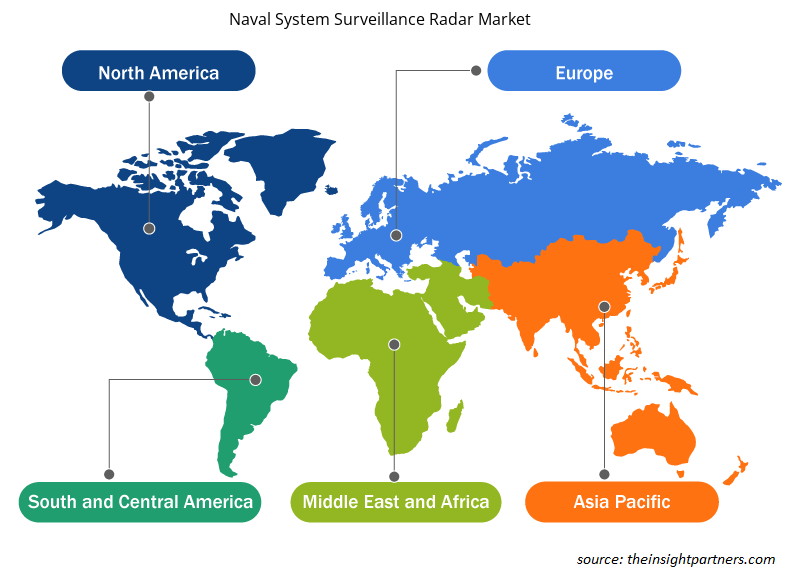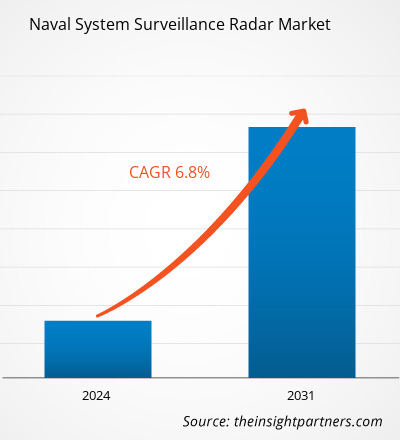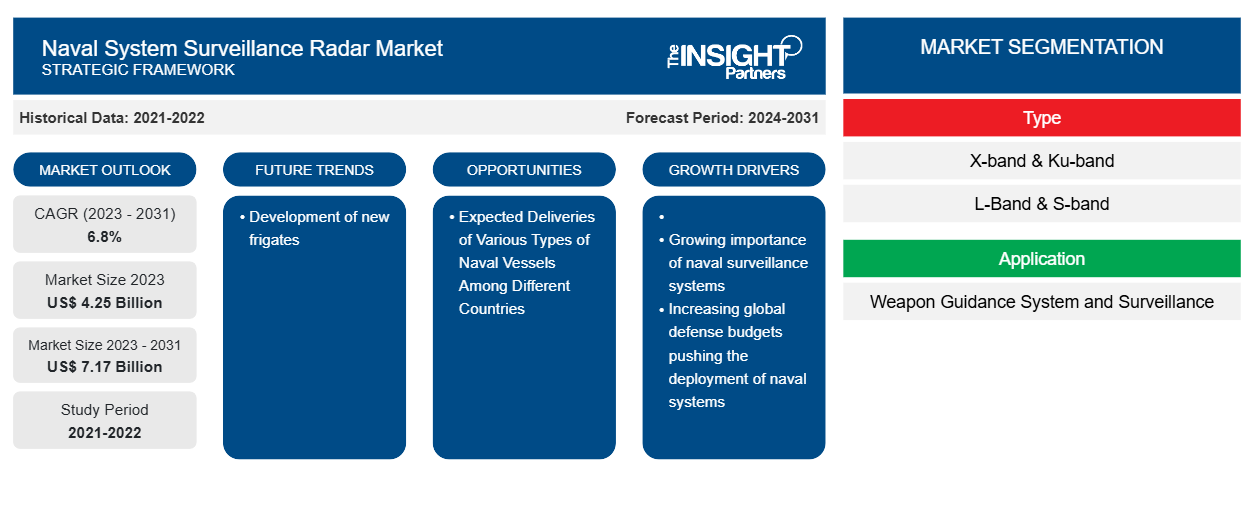해군 시스템 감시 레이더 시장 규모는 2023년 42억 5천만 달러에서 2031년 71억 7천만 달러로 성장할 것으로 예상됩니다. 이 시장은 2023~2031년 동안 6.8%의 CAGR을 기록할 것으로 예상됩니다 . 새로운 호위함 개발은 시장의 주요 추세로 남을 가능성이 높습니다.
해군 시스템 감시 레이더 시장 분석
해군 시스템 감시 레이더는 해군군에서 명령, 감시, 항해, 해군 정보 등 여러 가지 주요 제품 중 하나입니다. 해군 시스템 감시 시장에서 대체품 위협은 낮거나 낮습니다. 해군 부문이 전 세계적으로 국가 안보 및 항해 훈련을 위해 해군 시스템 감시 레이더만 조달한다는 사실 때문입니다. 따라서 현재 시나리오에서는 완전한 대체품을 시장에서 구할 수 없습니다. 그러나 기술 업그레이드와 진보가 우세합니다. 따라서 해군 시스템 감시 레이더 시장에 대한 대체품 위협의 영향은 향후 몇 년 동안 낮을 것으로 예상됩니다.
해군 시스템 감시 레이더 시장 개요
글로벌 해군 시스템 감시 레이더 시장 생태계의 주요 이해 관계자로는 구성 요소 제조업체, 해군 시스템 감시 레이더 제조업체, 최종 사용자 등이 있습니다 . 해군 레이더 시스템은 시스템 제조업체가 방대한 구성 요소 제조업체 기반에서 조달하는 다양한 구성 요소로 구성됩니다. 이러한 구성 요소 제조업체는 글로벌 해군 시스템 감시 레이더 플레이어에게 기본 부품을 공급합니다. 제조업체는 각 구성 요소를 통합한 후 최종 감시 레이더 시스템을 제조하는 회사입니다. 시장에서 활동하는 주요 기업으로는 Lockheed Martin Corporation, Northrop Grumman Corporation, Raytheon Technologies Corporation, Saab AB, Thales Group 등 이 있습니다. 글로벌 해군 시스템 감시 레이더 시장의 최종 사용자로는 전 세계 모든 해군이 포함됩니다. 해군은 감시 및 무기 유도 시스템과 같은 애플리케이션을 위해 레이더를 잠수함, 보트, 선박, 해군 함정 등과 통합합니다.
귀하의 요구 사항에 맞게 이 보고서를 사용자 정의하세요
이 보고서의 일부 또는 국가 수준 분석, Excel 데이터 팩을 포함하여 모든 보고서에 대한 사용자 정의를 무료로 받을 수 있으며 신생 기업 및 대학을 위한 훌륭한 혜택과 할인 혜택을 이용할 수 있습니다.
-
이 보고서의 주요 시장 동향을 알아보세요.이 무료 샘플에는 시장 동향부터 추정 및 예측까지 다양한 데이터 분석이 포함됩니다.
해군 시스템 감시 레이더 시장 동인 및 기회
증가하는 글로벌 방위 예산으로 해군 시스템 배치가 촉진됨
세계 군사 지출의 증가는 다양한 지역에서 레이더를 포함한 해군 시스템의 조달 및 배치를 촉진하는 주요 요인 중 하나입니다. 예를 들어, 스톡홀름 국제 평화 연구소( SIPRI )가 발표한 데이터에 따르면, 2019년에서 2022년 사이에 세계 군사 지출은 약 8.4% 증가했으며, 이는 군사 기술 에 대한 투자가 급증했음을 보여줍니다 . 이러한 요인은 해군 시스템 배치를 촉진하여 해군 시스템 감시 레이더 시장의 성장을 촉진했습니다.
다양한 국가 간 다양한 유형의 해군 함정의 예상 인도
호위함, 코르벳함, 항공모함, 잠수함, 구축함과 같은 다양한 유형의 해군 함정의 향후 인도가 예상됨에 따라 향후 몇 년 동안 다양한 지역에서 해군 시스템 감시 레이더에 대한 수요가 증가할 가능성이 높습니다. 예를 들어, 2023년에 미국은 약 243척의 해군 함정을 보유하고 있었습니다. 또한 The Insight Partner의 2차 조사에 따르면, 15척의 호위함, 21척의 구축함, 19척의 잠수함, 9척의 항공모함, 3척의 순찰선을 포함한 65척 이상의 해군 함정에 대한 주문이 이미 미국 해군에서 이루어졌습니다. 이는 미국에서 해군 시스템 감시 레이더의 새로운 설치에 대한 수요를 더욱 증가시킬 것입니다. 이러한 요소는 향후 몇 년 동안 시장 공급업체에게 새로운 기회를 창출할 가능성이 높습니다.
해군 시스템 감시 레이더 시장 보고서 세분화 분석
해군 시스템 감시 레이더 시장 분석에 기여한 주요 세그먼트는 유형과 응용 분야입니다.
- 유형에 따라 해군 시스템 감시 레이더 시장은 X-밴드 & Ku-밴드, L-밴드 & S-밴드, 기타로 세분화됩니다. X-밴드 & Ku-밴드 세그먼트는 2023년에 더 큰 시장 점유율을 차지했습니다.
- 응용 프로그램을 기준으로 해군 시스템 감시 레이더 시장은 무기 유도 시스템과 감시로 세분화됩니다. 감시 부문은 2023년에 더 큰 시장 점유율을 차지했습니다.
지역별 해군 시스템 감시 레이더 시장 점유율 분석
해군 시스템 감시 레이더 시장 보고서의 지리적 범위는 주로 북미, 유럽, 아시아 태평양, 중동 및 아프리카, 남미의 5개 지역으로 나뉩니다.
북미는 2023년 시장을 지배했고 그 뒤를 유럽과 아시아 태평양 지역이 따랐습니다. 나아가 아시아 태평양 지역도 향후 몇 년 동안 가장 높은 CAGR을 보일 가능성이 높습니다. 미국은 2023년 북미 해군 시스템 감시 레이더 시장을 지배했습니다. 미국은 레이더 기술의 조기 도입으로 인해 북미 해군 시스템 감시 레이더 시장에서 가장 큰 점유율을 차지하고 있습니다. 또한 미국은 세계에서 가장 큰 국방 예산을 보유하고 있으며 많은 예산이 업그레이드된 무기 시스템의 도입 및 조달에 사용됩니다. 미국 교통부 해사청(MARAD)의 조사에 따르면 조선 산업은 국가 GDP에 상당히 기여합니다. 2023 회계연도 해군부의 전체 예산 요청은 2,308억 달러이며 해군은 1,805억 달러, 해병대는 503억 달러를 받습니다. 해군은 2023 회계연도 대비 5.4% 증가한 533억 5천만 달러의 조달 자금을 요청하고 있습니다. 이는 전국의 해군 시스템 감시 레이더 수요에 기여합니다. 미국은 세계 3위이며 Global Firepower에 따르면 해군 함대는 484개입니다. 미국 해군의 함대 증가는 또한 해당 국가의 해군 시스템 감시 레이더 시장 성장을 뒷받침하는 요인으로 작용합니다.
해군 시스템 감시 레이더 시장 지역 통찰력
Insight Partners의 분석가들은 예측 기간 동안 해군 시스템 감시 레이더 시장에 영향을 미치는 지역적 추세와 요인을 철저히 설명했습니다. 이 섹션에서는 북미, 유럽, 아시아 태평양, 중동 및 아프리카, 남미 및 중미의 해군 시스템 감시 레이더 시장 세그먼트와 지리에 대해서도 설명합니다.

- 해군 시스템 감시 레이더 시장에 대한 지역별 데이터 얻기
해군 시스템 감시 레이더 시장 보고서 범위
| 보고서 속성 | 세부 |
|---|---|
| 2023년 시장 규모 | 42억 5천만 달러 |
| 2031년까지 시장 규모 | 71억 7천만 달러 |
| 글로벌 CAGR (2023-2031) | 6.8% |
| 역사적 데이터 | 2021-2022 |
| 예측 기간 | 2024-2031 |
| 다루는 세그먼트 |
유형별로
|
| 포함된 지역 및 국가 |
북아메리카
|
| 시장 선도 기업 및 주요 회사 프로필 |
|
시장 참여자 밀도: 비즈니스 역학에 미치는 영향 이해
해군 시스템 감시 레이더 시장은 소비자 선호도의 변화, 기술 발전, 제품의 이점에 대한 인식 증가와 같은 요인으로 인해 최종 사용자 수요가 증가함에 따라 빠르게 성장하고 있습니다. 수요가 증가함에 따라 기업은 제품을 확장하고, 소비자의 요구를 충족하기 위해 혁신하고, 새로운 트렌드를 활용하여 시장 성장을 더욱 촉진하고 있습니다.
시장 참여자 밀도는 특정 시장이나 산업 내에서 운영되는 회사나 기업의 분포를 말합니다. 주어진 시장 공간에 얼마나 많은 경쟁자(시장 참여자)가 존재하는지 그 규모나 전체 시장 가치에 비해 나타냅니다.
해군 시스템 감시 레이더 시장에서 운영되는 주요 회사는 다음과 같습니다.
- 록히드 마틴 주식회사
- 노스럽 그러먼 코퍼레이션
- 레이시온 테크놀로지스 코퍼레이션
- 사브 AB
- 탈레스 그룹
- BAE 시스템
면책 조항 : 위에 나열된 회사는 어떤 특별한 순서에 따라 순위가 매겨지지 않았습니다.

- 해군 시스템 감시 레이더 시장 주요 주요 업체 개요를 알아보세요
해군 시스템 감시 레이더 시장 뉴스 및 최근 개발
해군 시스템 감시 레이더 시장은 1차 및 2차 연구 이후의 정성적, 정량적 데이터를 수집하여 평가합니다. 여기에는 중요한 기업 간행물, 협회 데이터 및 데이터베이스가 포함됩니다. 해군 시스템 감시 레이더 시장의 몇 가지 개발 사항은 다음과 같습니다.
- 노스럽 그러먼 코퍼레이션은 미국 해군의 G/ATOR 레이더 기술 개조를 위해 1억 6,700만 달러 상당의 계약을 확보했습니다. (출처: 노스럽 그러먼 코퍼레이션, 보도자료, 2024년 4월)
- 미국 해군은 29척의 신규 함선에 첨단 AN/SPY-6 해군 레이더를 장착하고 있으며, 이제 RTX 사업인 Raytheon과 6억 1,900만 달러 규모의 계약을 맺고 첫 번째 기존 함선에 이 시스템을 추가할 예정입니다. (출처: Raytheon Technologies Corporation, 보도자료, 2023년 4월)
해군 시스템 감시 레이더 시장 보고서 범위 및 제공물
"해군 시스템 감시 레이더 시장 규모 및 예측(2021-2031)" 보고서는 아래 영역을 포괄하는 시장에 대한 자세한 분석을 제공합니다.
- 범위에 포함된 모든 주요 시장 세그먼트에 대한 글로벌, 지역 및 국가 수준의 해군 시스템 감시 레이더 시장 규모 및 예측
- 해군 시스템 감시 레이더 시장 동향 및 드라이버, 제약 및 주요 기회와 같은 시장 역학
- 포터의 5가지 힘에 대한 자세한 분석
- 주요 시장 동향, 글로벌 및 지역 프레임워크, 주요 업체, 규정 및 최근 시장 개발을 포괄하는 해군 시스템 감시 레이더 시장 분석
- 시장 집중도, 히트맵 분석, 유명 업체 및 해군 시스템 감시 레이더 시장의 최근 개발 사항을 다루는 산업 환경 및 경쟁 분석
- 자세한 회사 프로필
- 과거 분석(2년), 기준 연도, CAGR을 포함한 예측(7년)
- PEST 및 SWOT 분석
- 시장 규모 가치/거래량 - 글로벌, 지역, 국가
- 산업 및 경쟁 환경
- Excel 데이터세트
최근 보고서
관련 보고서
사용 후기
구매 이유
- 정보에 기반한 의사 결정
- 시장 역학 이해
- 경쟁 분석
- 고객 인사이트
- 시장 예측
- 위험 완화
- 전략 기획
- 투자 타당성 분석
- 신흥 시장 파악
- 마케팅 전략 강화
- 운영 효율성 향상
- 규제 동향에 발맞춰 대응























 무료 샘플 받기 - 해군 시스템 감시 레이더 시장
무료 샘플 받기 - 해군 시스템 감시 레이더 시장